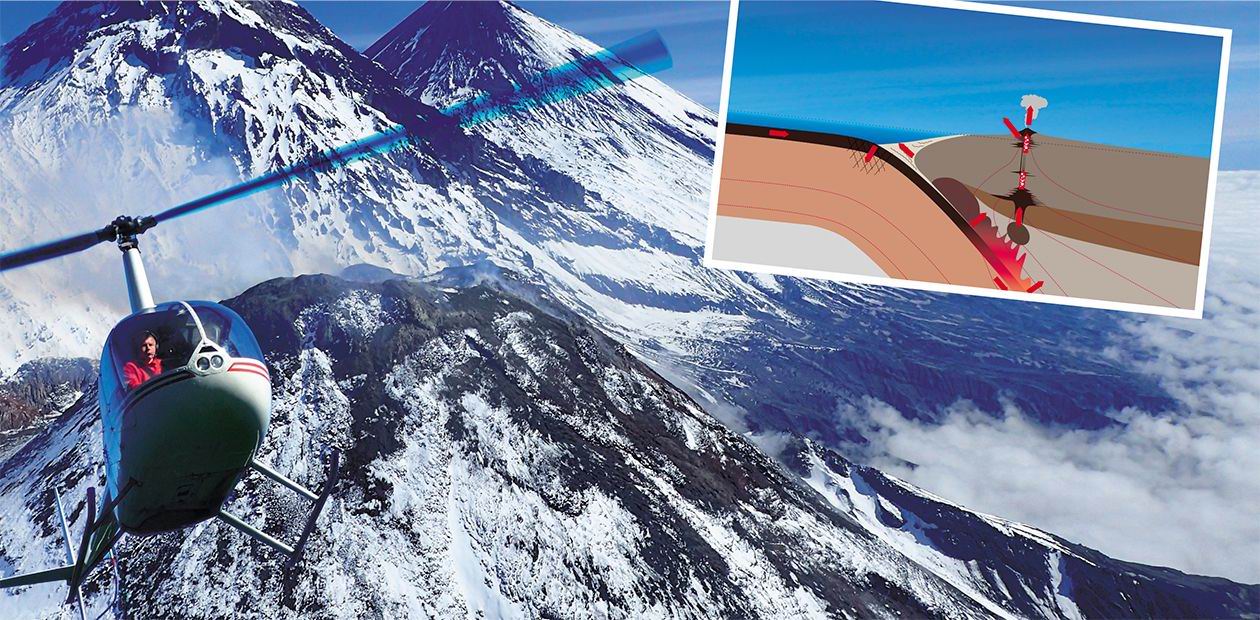Catastrophic Volcanic Eruptions: Is the Humankind Prepared for Them?
We are used to permanence in the world around us and are often hit hard by any changes in the environment. This is not surprising – modern humankind is lucky because our civilization was developing during a favorable and relatively quiet planetary period. However, human life span does not exceed a hundred years; industrial society is only a few centuries old; and the written history of humankind extends no more than a few millennia. These are very short time periods on a geological scale yet the long history of the biosphere contains “records” of many global catastrophic events, such as climate changes due to powerful volcanic eruptions. Scientists have learned to read these records but they still cannot confidently predict upcoming disasters
Volcanic eruptions pose – because of their consequences – no less of a threat or, perhaps, even a greater threat to the humankind than a nuclear war, the fall of a large meteorite, or any other global catastrophe. Furthermore, we appear to underestimate the danger coming from volcanoes.
Nuclear war is a very real threat but we have the power not to let it happen. As for meteorites, we only have guesses and indirect clues about biospheric catastrophes caused by them, but there is no reliable evidence.
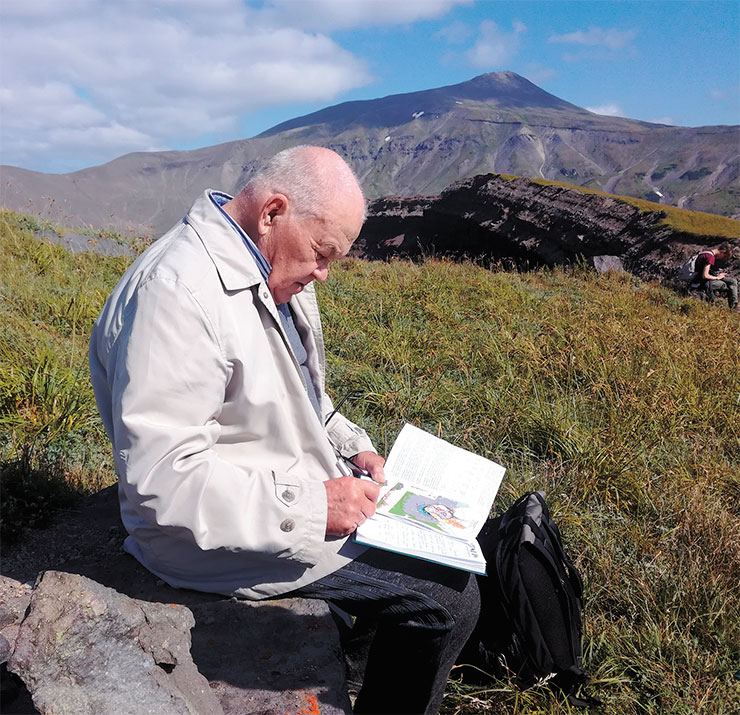
The history of humankind saw many catastrophic eruptions with tangible environmental consequences, including the eruptions of the Toba and Krakatoa Volcanoes in Indonesia. However, the largest eruption, in fact, an ecological catastrophe, which threatened to destroy all life on the Earth, occurred on the boundary between the Permian and Triassic 250 million years ago. This event was associated with eruptions of the Siberian trap rocks (i. e., a vast volcanic system in the northeast of the Eurasian continent, where many volcanoes were erupting simultaneously for about a million years) and with similar magmatic events that likely occurred in the oceans. Unfortunately, nothing now remains of the Permian oceanic crust.
This volcanic activity is believed to have led to the extinction of almost 80 % of all biological species (more than 90 % in quantity), i. e., almost all life on the Earth, although life recovered afterwards quiet quickly by geological standards. What happened once may happen again, but the probability of preserving (or restoring) human civilization after such a catastrophe is vanishingly small.
Year without a summer
One of the most recent major eruptions occurred 74,000 years ago at the Toba Volcano, which is located in Indonesia in the so-called subduction zone, where the oceanic crust submerges underneath the lithospheric plate. There is an assumption that this catastrophe resulted in a dramatic decrease in the population of the ancestors of modern humans (De Vivo et al., 2001).
The eruption of another Indonesian volcano – Krakatoa – in the 1st century CE is associated with the sharpest cooling in the last two millennia. And only two centuries ago, an extremely violent eruption occurred at the Indonesian volcano Tambora, as a result of which the average global temperature dropped by about one degree. That “year without a summer” with a series of summer frosts caused widespread crop failures in vast areas of the Northern Hemisphere, including the United States, Canada, and Northern Europe, which led to famine and disease. By analogy with nuclear winter, this phenomenon is now called volcanic winter – it was caused by huge amounts of eruptive volcanic dust and gases that got into the stratosphere, where they circulated for several years, scattering and reflecting solar radiation, and thus leading to a prolonged cooling.
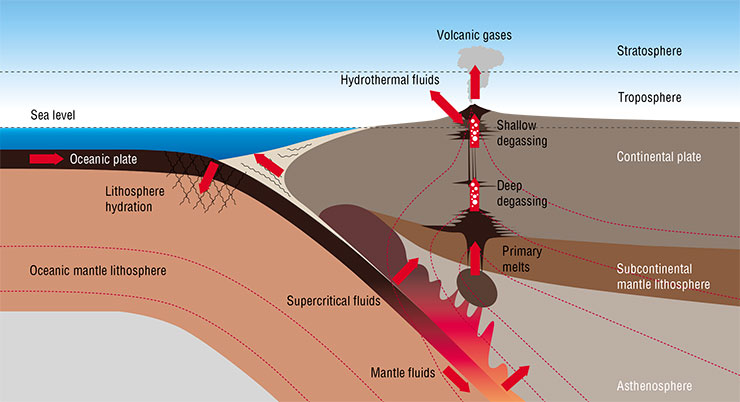
Among the above examples of catastrophic eruptions, only one event can be formally attributed to the so-called super-eruptions, in which explosive emissions reach at least 1,000 km3 in solid equivalent. In total, twenty such supervolcanoes are known on the Earth, and for three of them, it has been confirmed that they have erupted over the past million years: Toba in Indonesia, Yellowstone in the northwestern United States, and Taupo in New Zealand. There are reasons to believe that large eruptions of this kind could have occurred in other sparsely populated areas, such as Kamchatka, but there is no evidence left or none has been found yet.
However, as we see, smaller eruptions also have global effects, e. g., emissions during the Tambora eruption in 1815 amounted to 180 km3 of ash and volcanic material (tephra). Therefore, in a practical sense, we pay great attention to all volcanoes that can eject into the upper layers of the atmosphere such a large volume of eruptive products that, taking into account the features of atmospheric circulation, they can cause pronounced and long-term climate changes.
Until recently, it was believed that such events occur quite rarely – on average, once a millennium, which inspired optimism, given the duration of human life. But the results of recent studies in the ice of Greenland and Antarctica have yielded other, shocking figures.
Once in a century?
The history of catastrophic eruptions accompanied by stratospheric ejections can now be traced from the finds of volcanic ash discovered by drilling the ice cover in Greenland and Antarctica. Today, scientists can analyze the composition of the retrieved samples to determine where this ash came from – whether it is from Kamchatka, Japan, or other places. A presentation on this topic was made at an international volcanological conference in Petropavlovsk-Kamchatsky in August 2018 by V. V. Ponomareva, Doctor of Sciences in Geography (Ponomareva et al., 2013, 2015).
The number of works on this subject has now increased by an order of magnitude, published mostly by Western authors. In our country, such studies are now underway at the Institute of Volcanology and Seismology, Far Eastern Branch, Russian Academy of Sciences (IVS FEB RAS, Petropavlovsk-Kamchatsky) and the Limnological Institute, Siberian Branch, Russian Academy of Sciences (LIN SB RAS, Irkutsk). By analyzing changes in the sulfur isotope composition in ice samples from the Mirny and Vostok stations, located in the continental part of Antarctica, researchers from the LIN SB RAS and their colleagues in Greenland found traces of volcanic ash, i. e., evidence of catastrophic eruptions (Khodzher et al., 2011; 2015). However, they could not identify where exactly these eruptions occurred.
Throughout the Earth’s history, periods of warming have always alternated with periods of cooling. In addition to astronomical factors, the planet’s climate is also influenced by the global oceanic “conveyor belt” of currents, which depends on the location of high mountains and the continents themselves. One of the most important factors underlying the climate variations is the changes in the intensity and nature of volcanism with a periodicity of up to tens of thousands of years, as a result of which a huge amount of greenhouse gases can enter the atmosphere, far exceeding modern anthropogenic emissions (Dobretsov, 2010)The results of studying volcanic ash in the ice cores of Greenland and some other glaciers showed that eruptions of about the same scale as Krakatoa or Tambora occurred on average once every 100 years, i. e., an order of magnitude more frequently! In other words, we can well expect such an event in our century. This kind of periodicity means a different scale and different expectations, especially considering the current population of humankind and the degree of development of the planet’s territory.
The main danger posed by the expected catastrophic eruption comes not from the direct threat to local population, which is undoubtedly daunting, but with global consequences, i. e., pollution and clouding of the atmosphere due to the release of ash and gas. Even after a relatively small eruption of the Bezymyanny volcano in Kamchatka in 1956, which “woke up” after three thousand years of quietude, the column of volcanic smoke reached 30 km, sometimes even 80 km, for two months, which means that the emissions were circulating for a very long time in the atmosphere. Fortunately, at that time, airplanes did not fly so high; otherwise, air traffic could have been paralyzed for a decade.
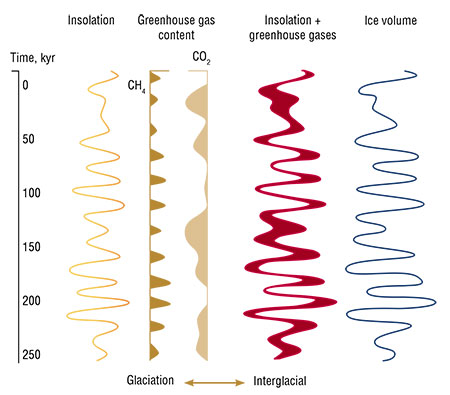
Today, satellites enable us to assess the details and effects of eruptions at almost any scale. For example, the last major fissure eruption of the Tolbachik Volcano in the east of Kamchatka caused an ejection of a large amount of hydrogen sulfide. When oxidized, hydrogen sulfide leads to the formation of crystals of native sulfur, which is why this volcanic cloud was easily traced – it turned out that it had been “wandering” around Asia and Arctic for several years (Gordeev and Dobretsov, 2017; Zelenski et al., 2014).
Furthermore, the sulfur itself that comes from volcanic emissions poses a considerable danger. Hydrogen sulfide, which had oxidized to sulfuric acid, could have become a cause of the mass death of living beings after the eruption of the Siberian traps. Sulfuric acid was not only pouring onto the heads of all living beings but also noticeably changed the acidity of the planet’s water shell – mostly, rivers and lakes; the world ocean, too, was affected. And back then, life was concentrated predominantly in aquatic medium.
I do not think that a catastrophe on the scale of the Siberian trap eruptions can possibly happen today, but an event as powerful as the Tambora eruption is quite possible. And the consequences of such an event for a densely populated planet will be catastrophic because it will affect not only climate and agriculture but also industry, communications, transport, etc. For example, in April 2010, the activity of the Eyjafjallajökull volcano in Iceland increased sharply, leading to the emission of no more than 1 km3 of tephra into the atmosphere. As a result, thousands of flights were canceled in northern Europe, and the airspace over this part of the continent remained effectively closed for 10 days. What if such a transport collapse continues for months or years and, on top of that, is global? Today one can hardly imagine the consequences of such an event…
Using modern methods for estimating the volumes of volcanic emissions, we can identify in the Earth’s past not only supereruptions but also other large eruptions that could have affected the Earth’s climate system. This influence can be assessed both by direct and indirect signs.
The former include traces of ash that are found in Greenland, in Antarctica, and on the Svalbard and Novaya Zemlya archipelagos in the Arctic Ocean – now we can accurately establish that these precipitations were falling there for more than one year. Indirect evidence may include changes in the global content of certain elements.
CLIMATE CHANGE: IS СО2 SO BIG OF A CULPRIT? Today, most discussions on climate change in the media boil down to reducing anthropogenic carbon dioxide emissions into the atmosphere in order to reduce the greenhouse effect leading to climate warming. According to a number of foreign experts, the current total anthropogenic CO2 emissions are approximately an order of magnitude higher than volcanic ones.This question certainly deserves a detailed study. But here we have an interesting point – as evidenced by the results of studies of Antarctica and Greenland ice, which contains ancient air “bubbles,” the changes in the atmospheric CO2 concentrations came after the changes in temperature; i. e., the climate changed first and only then did the carbon dioxide content in the air (Kotlyakov, 2014; Dobretsov, 2011). So there is a possibility that now we are confusing cause and effect.
Another such issue is the much-speculated problem of ozone layer destruction due to the release of freons and other anthropogenic compounds. Scientists from the Institute of Biophysics SB RAS in Krasnoyarsk have developed a well-reasoned and calculated theory about the natural mechanism underlying the dynamics of atmospheric ozone (Kashkin and Khlebopros, 2007; Khlebopros and Kashkin, 2017)
For example, these are anoxic events in the oceans due to a global oxygen deficiency, which led to the deposition of black silts enriched in C and S. Several such catastrophic situations occurred from 70 to 100 million years ago, and they still remain unexplained, generating various hypotheses. If these black silts are found to be correlated with volcanic activity, we might come closer to understanding the causes and mechanisms behind them. To this end, we should continue research on glaciers and look for other effects dated to the same time in ocean sediments. The scope of this work is huge, and it requires planning.
By the way, specialists from the IVS FEB RAS and LIN SB RAS, who work together with foreign colleagues, have learned not only to trace volcanic ash in ice but also to estimate the magnitude of an eruption itself by more subtle effects, i. e., changes in certain isotopic ratios of sensitive elements in the fallen snow (Khodzher et al., 2011; Ponomareva et al., 2015).
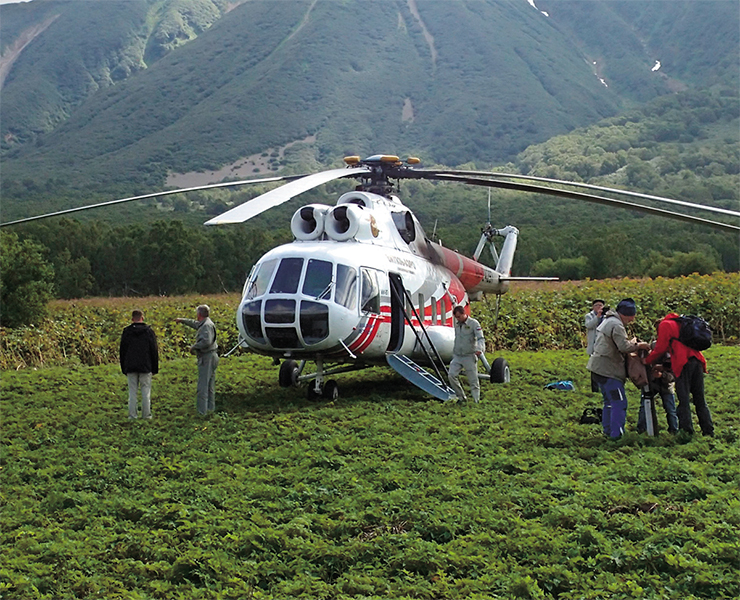
For example, now we know that our Kamchatka volcanoes, too, are capable of throwing dust and gas into the upper atmospheric layers. Previously, the only “suspect” was the Bezymyanny Volcano, which erupted for the last time in 1956. Now, the same ice of Greenland is found to contain traces of large eruptions of the Ksudach Volcano, one of the most fascinating volcanic massifs in Kamchatka, which erupted twice: in the 1st and 8th centuries CE. The high occurrence of these ashes testifies to the power of the eruption and to the large volumes of eruptive matter, which had been spread by air currents throughout the world for several years.
Of course, such projects mean, first of all, a lot of money. In this regard, I cannot but give an illustrative example. It is known that Hawaii is a chain of islands of volcanic origin, which owes its emergence to a mantle plume, i. e., a jet of molten substance rising from great depths to the planetary surface. The Hawaiian plume is 90 million years old, and it was this plume that “burned out” a chain of volcanoes, both dormant and active, in the moving lithospheric crust. The Hawaiian hotspot has been studied for more than a hundred years by a dedicated research institute, a large and well-funded one. Nevertheless, specialists still do not know where the plume’s trail goes – maybe straight to the core?
WHEN WILL THE NORTH MAGNETIC POLE BECOME THE SOUTH ONE? Another natural phenomenon that is catastrophic for humans and is beyond our control is the inversion (change of the poles) of the Earth’s magnetic field. This phenomenon has an extremely long-term periodicity – in total, about 500 such events have occurred over the past 500 million years, i. e., one or two inversions per a million years. The fact that the last inversion happened about 800,000 years ago inspires concern. The deadline is approaching, but no one knows when it comes: in 30, 300, or 300,000 years.Today the poles, especially the North Pole, do not stand still, and sometimes their movement accelerates noticeably. Fortunately, for a short period so far. But the fluctuations will occur more and more often, and when the pole crosses the 60th parallel, it will not come back. The process of “rocking” and inversion may take up to a thousand years, and this entire period will be a rough time for humanity. True, the duration of the transition period is known with very little accuracy because no one has ever dealt closely with this problem.
The magnetic field has been studied for more than 300 years, but no plausible hypothesis has yet been proposed for why and, most importantly, how the inversion occurs although these events are “recorded” in volcanic lavas, where we observe a change in polarity and can roughly estimate the period (about one thousand years) during which it occurs.
Unlike volcanoes, the task here is more comprehensible, i. e., one needs to organize enhanced monitoring of the magnetic field, first of all, fluctuations in the positions of the magnetic poles. It is known, e. g., that during each inversion, the North Pole “ran” along the same route through the present Chukotka and Kamchatka to Japan and further, through Australia, to the current South Pole. Now detailed monitoring of the magnetic pole is carried out only by a special service in Canada, but this effort is clearly insufficient because this task requires the combined efforts of international scientific organizations, including Russian ones. Moreover, it is necessary to conduct research and calculations on how the weakening of the magnetic field and its chaotic variations during an inversion (about one thousand years) will affect the operation of power generators, electrical appliances, communications, television, etc.
One can hardly find this out using conventional geophysical methods since the island is small but the coverage needs to be large. The Americans solved this problem by building a whole network of seismic stations at the bottom of the ocean. They spent about $4 billion (!) on it, purely for educational purposes. And they say that Americans are much more practical than Russians. Do we have at least one similar project?
Today it is well known that the threat of explosive eruptions with global consequences is much more real than it was previously thought. And it seems logical to devote time and money to solving this problem, at least the same $3–4 billion. However, no one offers this kind of money to us, Russian scientists, unlike in America.
Unfortunately, the activity of volcanoes does not depend on humans; we can neither prevent nor stop volcanic eruptions. The only thing we can do is to reduce the damage if we learn to predict and prognosticate catastrophic eruptions and can somehow prepare for them. What exactly can be done in this direction still remains unclear but if we formulate this task as a global challenge and attract the attention of the scientific community to it, constructive proposals will certainly appear.
References:
Belousov A., Belousova M., Edwards B. et al. Overview of the precursors and dynamics of the 2012–13 basaltic fissure eruption of Tolbachik Volcano, Kamchatka, Russia // J. Volcanol. Geotherm. Res. 2015. V. 307. P. 22–37.
Dobretsov N. L. Fundamentals of Tectonics and Geodynamics. Novosibirsk: Novosib. Gos. Univ., 2011 [in Russian].
Fissure Eruption of Tolbachik Volcano in 2012–2013 (ТFE-50) / Ed. by E. I. Gordeev and N. L. Dobretsov. Novosibirsk: Sib. Otd. Ross. Akad. Nauk, 2017 [in Russian].Khlebopros R. G. Kashkin V. B. Antarctic ozone hole – who is to blame? // NAUKA iz pervykh ruk. 2017. N 1. V. 73. P. 20–27 [in Russian].
Khodzher T. V., Golobokova L. P., Osipov E. Yu. et al. Evidence of volcanic eruptions at Tambora and Krakatoa (XIX) from the data of chemical and electron microscopic studies of snow–firn cores from the neighborhood of the Vostok station (Antarctica) // Led i sneg. 2011. N 1. P. 115–121.
Ponomareva V., Portnyagin M., Derkachev, А. et al. Early Holocene M~6 explosive eruption from Ushkovsky volcano (Kamchatka) and its tephra as a link between terrestrial and marine paleoenvironmental records // Int. J. Earth Sci. 2013. V. 102. № 6. P. 1673–1699.
Ponomareva V., Portnyagin M., Pevzner M. et al. Tephra from andesitic Shiveluch volcano, Kamchatka, NW Pacific: chronology of explosive eruptions and geochemical fingerprinting of volcanic glass // Intern. J. Earth Sci. 2015. V. 104. № 5. P. 1459–1482.


